Rust Family Foundation: Archaeology Grants Program
The Bioarchaeology of the Moche Lords of Úcupe:
New Windows on Politics, Identity, and Human Biology
Principal Investigator: Haagen D. Klaus, Associate Professor of Anthropology
George Mason University
The Moche culture emerged some 1,900 years ago on the arid north coast of Peru (fig.1). At their zenith, the Moche culture was an intensely hierarchical society. Their economy was fueled by large-scale systems of tribute and labor organization, irrigation agriculture, fishing, camelid herding, and long distance trade (Bawde
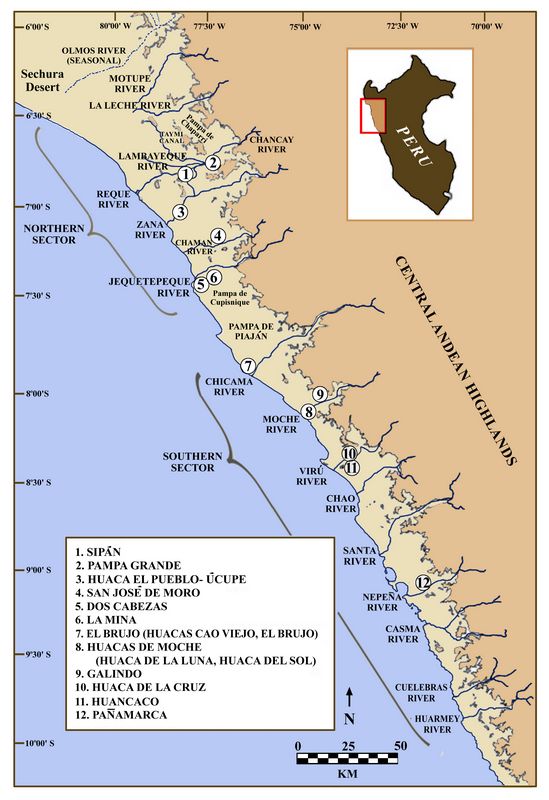 n
1996; Benson 2012; Shimada 1994a). At the apex was a group of powerful
leaders that integrated the regional political economy and ideological
system. Today, perhaps the most prominent, productive, and
contentious research focus involves the reconstruction of Moche
political organization (Quilter and Castillo 2010, Klaus et al., 2018).
n
1996; Benson 2012; Shimada 1994a). At the apex was a group of powerful
leaders that integrated the regional political economy and ideological
system. Today, perhaps the most prominent, productive, and
contentious research focus involves the reconstruction of Moche
political organization (Quilter and Castillo 2010, Klaus et al., 2018).
Fig.1: The north coast of Peru, highlighting major Moche-era sites including Huaca El Pueblo Úcupe,
Sipán, Dos Cabezas and others discussed in the text (map: Haagen Klaus.)
This project examining Moche skeletons from Úcupe was undertaken as part of the Lambayeque Valley Biohistory Project, which aims to characterize the last 15,000 years of human history in this unique cradle of human culture. The project has come to study the skeletal remains and funerary contexts of some 3,100 people who lived between 2400 B.C.E. and 1750 C.E. spanning 24 different sites throughout the Lambayeque Valley Complex. The project’s primary foci have aimed to characterize the origins, development, and history of pre-Hispanic and Colonial period complex societies along with how these changes were intertwined with biological transformations of the people themselves. Within this arc, particular thematic and conceptual interest involves the bioarchaeology of the Moche, who are so prominently represented in the artifactual record but whose skeletons have barely begun to reveal the details of their societies and the stories of individual lives, especially in the Lambayeque region.
Previous work at the sites and region::
Initial thoughts on Moche politics by Larco Hoyle (1938, 1939) and participants of the 1940s Virú Valley Project envisioned a pseudo-Western, centralized, and conquest-minded Moche state with its capital at the monumental Huacas de Moche (Strong and Evans 1952; Willey 1952). This simplistic notion was uncritically accepted for decades but began to erode in the 1990s with the recognition of signatures of two geopolitically distinct Moche macro-polities: the northern and southern Moche (Castillo and Donnan 1994; Shimada 1994b) (fig.1). Today, an even more nuanced “many worlds of the Moche” model is emerging that increasingly recognizes previously unimagined and distinct constellations of peoples, politics, and social identities (Benson 2012; Quilter and Koons 2012). Such findings represent a complete re-thinking of the Moche phenomenon to drive an even more fundamental series of reflections upon how archaeology approaches sociopolitical organization in Andean studies and beyond.
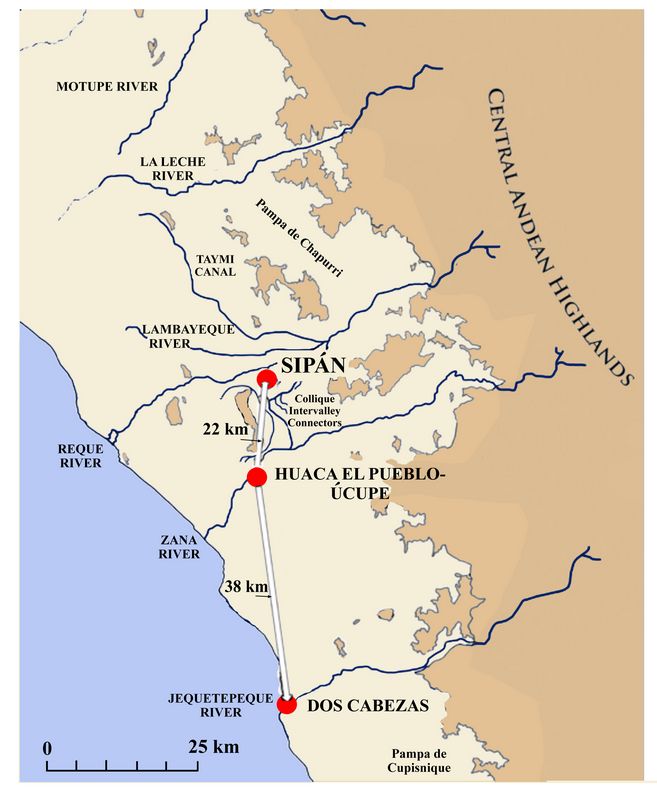 In light of the “many worlds” model, the lords at all Moche centers seem
closely linked by a shared ideological system on one hand
(Bourget 2014, 2016), and on the other, each group expressed those
ideas with remarkable differences at paramount Moche centers such as
Sipán (Alva 1994, 2001), Úcupe (Bourget, 2014), and Dos Cabezas
(Donnan, 2007) (fig.2).
In light of the “many worlds” model, the lords at all Moche centers seem
closely linked by a shared ideological system on one hand
(Bourget 2014, 2016), and on the other, each group expressed those
ideas with remarkable differences at paramount Moche centers such as
Sipán (Alva 1994, 2001), Úcupe (Bourget, 2014), and Dos Cabezas
(Donnan, 2007) (fig.2). Fig.2: Geographic locations and distances between Sipán, Úcupe, and Dos Cabezas (map: Haagen Klaus).
The discoveries of Moche royal tombs at the site of Huaca El Pueblo-Úcupe have been critical to further defining and testing hypotheses about Moche political organization. In 2008, Steve Bourget (2014) located one intact tomb containing the “Lord of Úcupe.” While in the inferred territory of Sipán, this man was biological kin with the distant lords of Dos Cabezas (Klaus et al., 2018). But at the same time, he was buried with all the symbols of power and identity used by the lords of Sipán. Did this represent another heretofore unknown polity, and another unknown “Moche world,” involving a distinct a hybrid sociopolitical identity at Úcupe? Another fundamental but still emergent question in Moche bioarchaeology involves how socioeconomic inequality shapes human biology and health outcomes (Klaus et al. 2017a,b,c). Among the Moche, it seems that two sets of disparate health outcomes emerged transcending whatever “Moche world” they participated in. Power, privilege, and elite status conferred superior nutrition and less biological stress to the lords while greater biological stress, morbidity, and lllness appears to have been concentrated among the non-elite peoples (Verano 1997). This work seeks to further define this epidemiological pattern.
Current project (RFF-2019-120)
Goals:
The study of the newly discovered tombs at Úcupe was guided by the project’s overarching research design of ‘contextual burial analysis’ (Klaus 2008). The aim was to create an informative configuration of theory, method, and analytical techniques to generate holistic biocultural reconstructions of ancient socioeconomic organization, paleopathology, population biology, and human-environment interplay. This project’s immediate goals were to test three linked hypotheses based on the 2019 Úcupe tombs:
Hypothesis 1: As Huaca El Pueblo-Úcupe appears to be a satellite settlement of Dos Cabezas – purposefully built in the Zaña valley to extend Dos Cabezas control over resources an territory in the backyard of Sipán, it was hypothesized that biodistance analysis of genetically inherited dental traits will link the people in the 2019 tombs to the Dos Cabezas elite lineage. Material culture, iconography, and other tangible embodiments of mortuary pattern variation that communicate group identity and affiliation will also align these individuals with the unique elite sub-style identified at Dos Cabezas (Donnan 2011; Bourget 2014; Klaus et al. 2018).
Hypothesis 2: Given the clear indications of elite status in the Úcupe tombs, it was hypothesized that skeletal biological and paleopathological data will also demonstrate elite lifestyle, privilege, and buffering from stress.
Hypothesis 3: Using comparative elite and non-elite Moche samples from the Lambayeque Valley Complex, we hypothesized these major social divisions will not only demonstrate different patterns of disease prevalence, but divergent trajectories of physiological constraint following the survival of early life stress events. Specifically, it is hypothesized that members of non-elite social origins will demonstrate greater prevalence of skeletal pathological conditions. By comparison, the Moche elite will express fewer indicators of stress, and where early life stress is found, this study hypothesizes that the social structure of this society these buffered individuals from future morbidity and mortality.
Methods:
Hypothesis One was tested via patterning of inherited dental traits and mortuary pattern variation. The basis of biodistance research is well established by evolutionary theory and has more than four decades of use in bioanthropology (Stojanowski and Schillaci 2006). Although there is never a 1:1 correspondence between genotype and phenotype, tooth development is under a strong degree of genetic control. Thus, patterns of genetic distance and kinship emerge from statistical analysis of linear measurements of tooth crown sizes and nonmetric cusp traits.
Data collection followed the procedures and standards outlined by Jacobi (2000) and Turner et al. (1991). Assessment of potential social group membership boundaries was assessed by Malhalanobis (D2) multivariate distance measures of metric and non-metric dental traits calculated in SPSS 26. Other vital data was derived from an estimate of population genetic heterogeneity (FST) and differential gene flow via R matrix analysis (Relethford 2016; Stojanowski 2005, 2013) in RMET 5.0. Mortuary pattern data was drawn from the project’s unpublished data sets, photos, drawings, and data recording forms and direct observations by the PI of the burials and grave goods themselves.
Hypothesis Two was tested through the inclusive study of multiple forms of skeletal biology. Biological sex was estimated from the morphological variation of the os coxae and the skull (Buikstra and Ubelaker 1994). Age-at-death was estimated using transition analysis (Boldsen et al. 2002). Measures of biological stress included the patterns of linear enamel hypoplasias present on anterior permanent teeth, crypt fenestration enamel defects of deciduous teeth, cribra orbitalia and porotic hyperostosis lesions of the orbits and cranial vault. Additional skeletal metabolic diseases, such as scurvy, pellagra, and mucopolysacchrydosis, skeletal growth patterns, and infectious disease burden were studied. Degenerative joint disease of the loadbearing joint systems, traumatic skeletal injuries were assessed to reconstruct lifestyle and physical activity patterns. Dietary reconstruction was accomplished via patterns of dental caries (cavities), antemortem tooth loss, periapical abscesses, calculus, and periodontal disease (Buikstra, 2019).
Hypothesis 3 compared enamel defect, anemia, infection, osteoarthritis, trauma, and periodontal disease patterns within and between Moche elite and non-elite peoples as defined by well-established markers of social status present in funerary context variation (Millaire 2002). Waldron (2007) and Klaus (2014) argued that odds ratios are the best method to compare patterns of prevalence in skeletal samples. Individuals were assigned into six standardized age classes based on the transition analysis data using an internally consistent seriation of skeletal maturity stages. Odds ratios were calculated for each age class that is the basis for common odds ratios – a summary statistic expressing prevalence differences in a simple and clear manner. Dental caries, antemortem tooth loss, and calculus are more amenable to analysis as count data.
In these cases, age class-dependent examination of prevalence differences were accomplished using G-tests, or a maximum likelihood chi square analysis (Sokal and Rohlf 1995). The linkages between skeletal lesions and life history traits, trade-offs, and phenotypic plasticity will be tested using the correlations and associations between stress events that occur during development and early life (and which are recorded more or less permanently in bones and teeth). This will be principally accomplished via the use of the Kaplan–Meier survival analysis to test the relationship between early life stress and survivorship. Survivorship curves are associated with the probability each individual survives S(t) at time t, or in this case, age-at-death. Survival was calculated as S(t) = ni-di/ni where ni is the number of survivors and is the number of deaths up to time i (Kaplan and Meir 1958). These curves are compared with a logrank test to test the null hypothesis that there is no difference between survival curves. Survivorship is then compared to individuals with and without evidence of enamel defects, anemia, infection, and other features
Findings:
Summary Description of the Tombs and Skeletal Remains:
The four newly discovered Úcupe tombs were located adjacent to the heavily looted area where the tomb of the Lord of Úcupe was documented in 2008. These contexts contained a total of six sets of human remains. They are contemporaneous with one another and the tomb of the Lord of Úcupe (Early Middle Moche period, 350/450 C.E.).
TOMB 1 (Field # Unit 1 Context 2 Tomb 1).
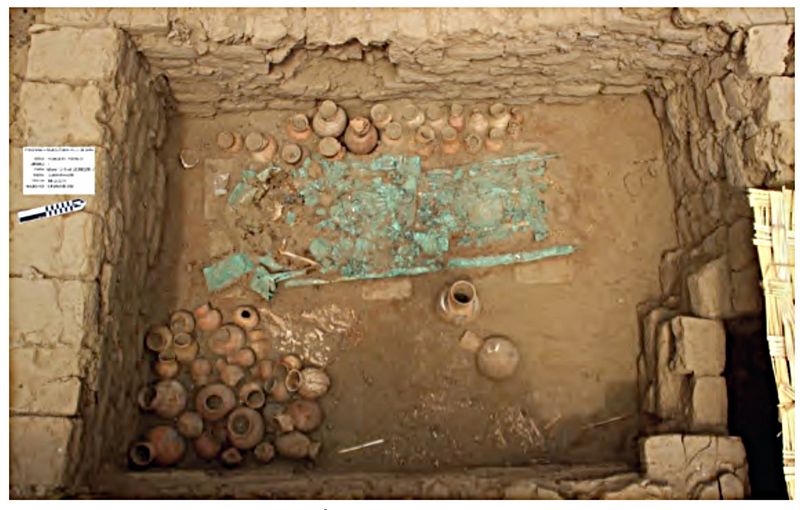 This
adobe brick chamber tomb contained the skeletal remains of a
high-status female individual between the ages of 45-50 (figs.3-7).
She was buried in standard Moche fashion, with the body in an extended,
supine position and the head in the south end of the grave (feet
pointing north). The body was placed on an unusual multi-part platform
consisting of three large adobe bricks.
This
adobe brick chamber tomb contained the skeletal remains of a
high-status female individual between the ages of 45-50 (figs.3-7).
She was buried in standard Moche fashion, with the body in an extended,
supine position and the head in the south end of the grave (feet
pointing north). The body was placed on an unusual multi-part platform
consisting of three large adobe bricks.Fig.3: Overall view of Úcupe Tomb 1 (photo: Edgar Bracamonte/ Museo Tumbas Reales de Sipán).
A diversity of items made from copper sheet was placed atop the body, from large diadems and crowns to small sheet metal objects (fig.3). To the left and right sides of
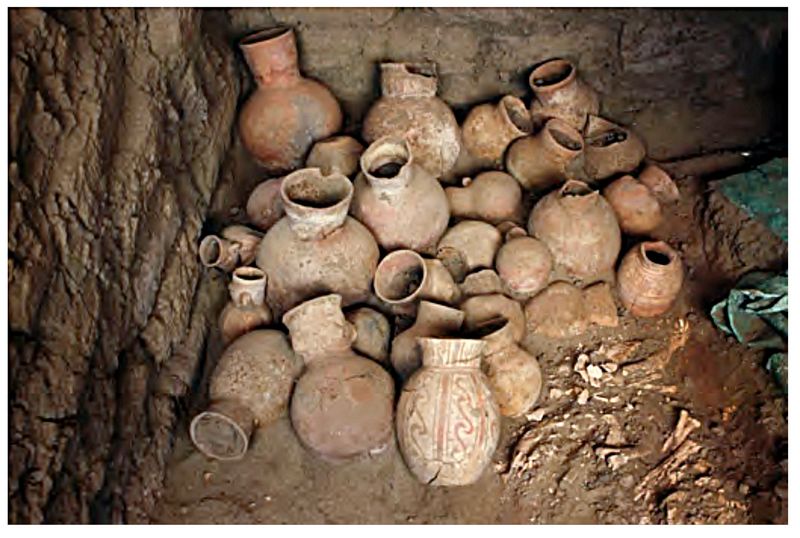 the body
were sheet metal war clubs, each nearly a meter and a half tall. These
were not functional implements of combat, but symbols previously
associated mostly with elite males and warrior status. Surrounding the
body were some 50 large, mass produced ceramic vessels (fig.4), presumably used
for the storage/offering of chicha beer. Some of these were classic
“face-neck” style jars with a sculptural depiction of a human face on
the tall neck of the vessel.
the body
were sheet metal war clubs, each nearly a meter and a half tall. These
were not functional implements of combat, but symbols previously
associated mostly with elite males and warrior status. Surrounding the
body were some 50 large, mass produced ceramic vessels (fig.4), presumably used
for the storage/offering of chicha beer. Some of these were classic
“face-neck” style jars with a sculptural depiction of a human face on
the tall neck of the vessel. Fig.4: Detail of the ceramic offering cache in the southeast corner of Tomb 1 (photo: Edgar Bracamonte/ Museo Tumbas Reales de Sipán).
Highly fragmented and poorly
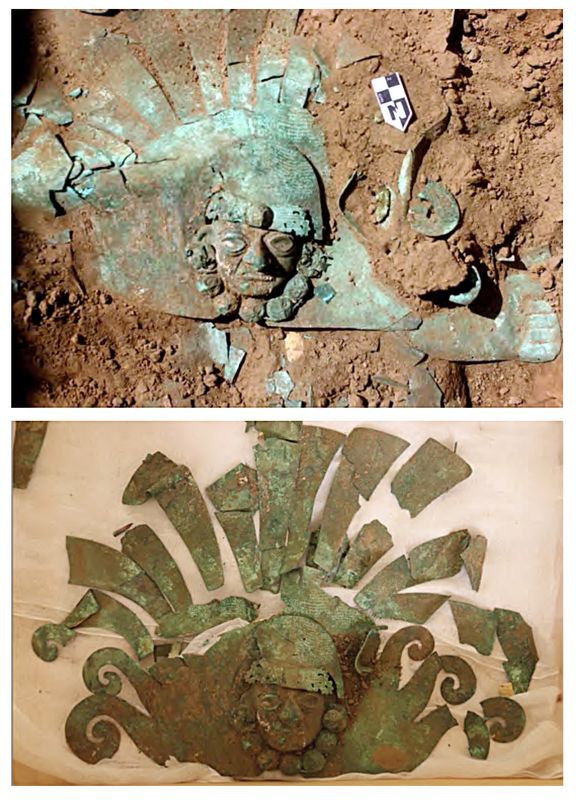 preserved
skeletal remains of two camelids (llama or alpaca) were also placed in
the tomb.
preserved
skeletal remains of two camelids (llama or alpaca) were also placed in
the tomb.The personage in Tomb 1 wore large, multi-part bracelets fashioned from extensively worked Conus fergusoni shell around the left and right forearms and held copper sheet disks on both hands (fig.6). A V-shaped diadem was also placed behind her head. The cranium was missing, as the tomb had been evidently re-opened in antiquity: the cranium was ritualistically removed following decomposition. This action followed a proscribed form of manipulation and interaction with the dead on the north coast of Peru (e.g., Shimada et al., 2015).
Figs.5-6: The large Sipán-sub-style diadem buried with the principal personage of Tomb 1 seen in situ (top) and following its removal (bottom). (Photos: Edgar Bracamonte/ Museo Tumbas Reales de Sipán).
The skeletal remains were fragmented, but the individual was complete except for the cranium. There were no enamel defects observed on the observable mandibular dentition. No evidence of chronic infectious disease processes, developmental disorders, metabolic disease, or other abnormalities were
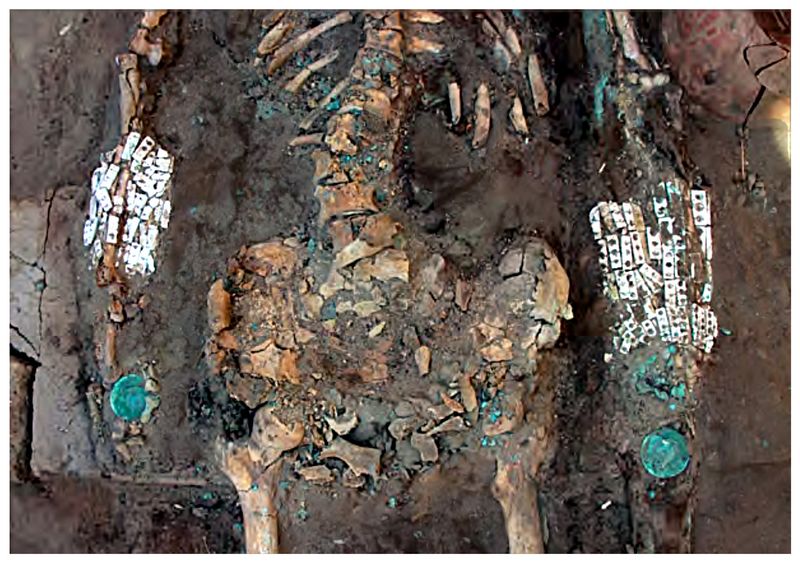 observed. Very mild degenerative joint disease was
present in the shoulder, thoracic and lumbar vertebrae, and hip join
systems. For a person of this age, such degeneration is not at all
unusual. One small dental caries was present and two teeth featured
deposits of calculus.
observed. Very mild degenerative joint disease was
present in the shoulder, thoracic and lumbar vertebrae, and hip join
systems. For a person of this age, such degeneration is not at all
unusual. One small dental caries was present and two teeth featured
deposits of calculus.Fig.7: Detail of the bracelets and copper items held in the hands of the Tomb 1 occupant (photo: Edgar Bracamonte/ Museo Tumbas Reales de Sipán).
TOMB 2 (Field # Unit 1 Context 3 Tomb 3).
Much to the surprise of the excavators, the principal personage of this tomb appear to have been an infant (figs.8-11). Dental development indicates an age-at-death between three to six months. Some 17 ceram
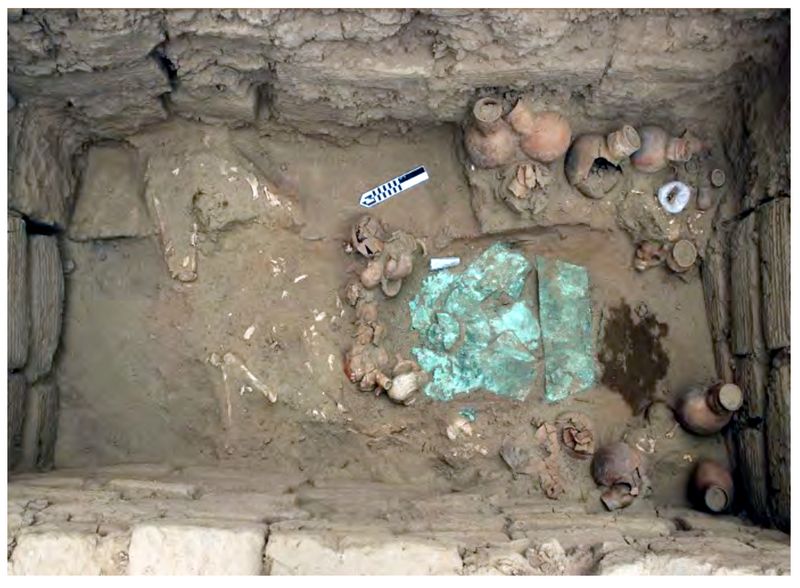 ic
vessels accompanied this infant. Many were nearly identical in size and
form to that in Tomb 1, while others were smaller, sculptural vessels.
One seems to depict a priest or shaman. A pair of smallsized
(approximately 1:4 scale) copper sheet war clubs were placed by the
left side of the body. The fragmented and poorly preserved skeletal
remains of a camelid were documented in the north end of the tomb.
ic
vessels accompanied this infant. Many were nearly identical in size and
form to that in Tomb 1, while others were smaller, sculptural vessels.
One seems to depict a priest or shaman. A pair of smallsized
(approximately 1:4 scale) copper sheet war clubs were placed by the
left side of the body. The fragmented and poorly preserved skeletal
remains of a camelid were documented in the north end of the tomb.Fig.8: Overall view of the contents and organization of Tomb 2. The skeletal remains of the principal personage – a three to six month-old infant – was under the copper metal object assemblage just to the right of center. (Photo: Edgar Bracamonte/Museo Tumbas Reales de Sipán.)
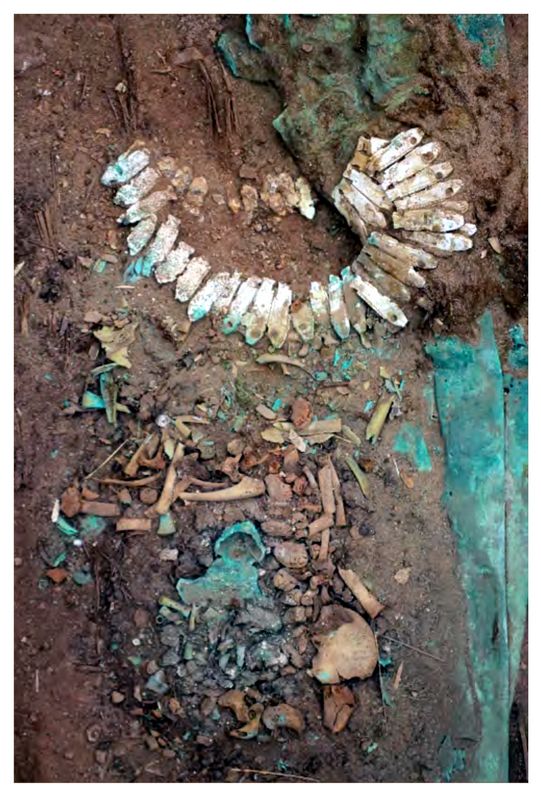 The
infant’s remains were found resting under a multi-piece, adult-sized
copper diadem that stylistically resembled items in Tomb 1 and also
those from the tomb of the Lord of Úcupe. An elaborate, adult-sized
worked Conus fergusoni shell necklace was placed around the neck.
However, the skeleton was significantly disarticulated, and indicates
the body was not buried immediately after death. The remains had been allowed
to naturally desiccate and mummify. When maneuvered into the chamber
tomb, the brittle remains appear to have shifted significantly and
disarticulated.
The
infant’s remains were found resting under a multi-piece, adult-sized
copper diadem that stylistically resembled items in Tomb 1 and also
those from the tomb of the Lord of Úcupe. An elaborate, adult-sized
worked Conus fergusoni shell necklace was placed around the neck.
However, the skeleton was significantly disarticulated, and indicates
the body was not buried immediately after death. The remains had been allowed
to naturally desiccate and mummify. When maneuvered into the chamber
tomb, the brittle remains appear to have shifted significantly and
disarticulated.Fig.9: The skeletal remains of the infant personage of Tomb 2 were highly disarticulated, and indicate they were buried some time after death. (Photo: Edgar Bracamonte/ Museo Tumbas Reales de Sipán.)
Another skeleton was found immediately underneath the infant. This was a fully articulated and complete skeleton of an adolescent individual of indeterminate sex and who died between the ages of 12-16. He or she was buried with a single undecorated utilitarian vessel placed between the upper thighs and wore a large and very unusual turban-like headdress. However, the only other comparable example in the Moche archaeological record was Burial 3 in the
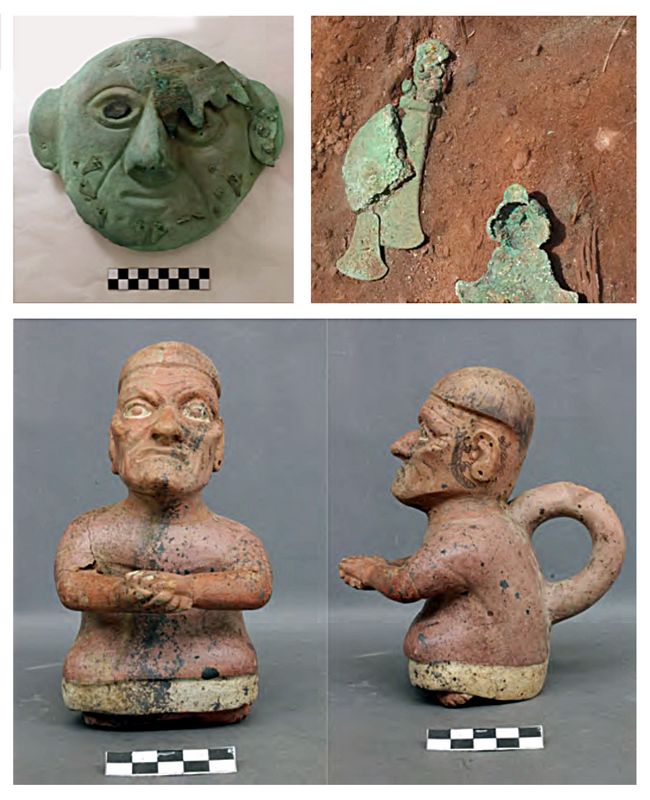 tomb of
the Lord of Úcupe (teenage female retainer) who wore nearly identical
headgear (Bourget, 2014). The lack of grave goods and physically
subordinate position (also seen in the tomb of the Lord of Úcupe)
indicate this person was intended to serve as a “companion” or funerary
retainer to the very young principle personage.
tomb of
the Lord of Úcupe (teenage female retainer) who wore nearly identical
headgear (Bourget, 2014). The lack of grave goods and physically
subordinate position (also seen in the tomb of the Lord of Úcupe)
indicate this person was intended to serve as a “companion” or funerary
retainer to the very young principle personage.No pathological conditions of any kind were observed in the infant’s skeleton. However, the retainer did display clear evidence of childhood acute and metabolic stress in the form of enamel hypoplasias, cribra orbitalia, and porotic hyperostosis. The retainer had excellent oral health and lacked any sign of dental pathology.
Fig.10 (top): Examples of metal objects in Tomb 2 included a copper burial mask (left) and copper tumi knives often associated with human sacrifice (right). (Photos: Edgar Bracamonte/ Museo Tumbas Reales de Sipán.)
Fig.11 (bottom): Ceramic vessel offering in Tomb 2 bearing a Dos-Cabezas sub-style form. (Photos: Edgar Bracamonte/ Museo Tumbas Reales de Sipán.)
TOMB 3 (Field # Unit 3 Disturbed Context 1).
Here, the skeletal remains of adult male individual, approximately 27-35 years of age at death was recovered in a looted tomb. Their original funerary assemblage will be forever impossible to ascertain since it was destroyed, but this was clearly another in a series of high-status tombs at Huaca El Pueblo-Úcupe. This person had suffered from acute childhood stress (enamel hypoplasias) and childhood anemia (porotic hyperostosis). Mild osteoarthritic changes were present in their tempromandibular and lumbar
vertebrae joint systems. Oral health was excellent apart from 16 teeth affected by deposits of dental calculus.
TOMB 4 (Unit 4 Context 1 Tomb 2).
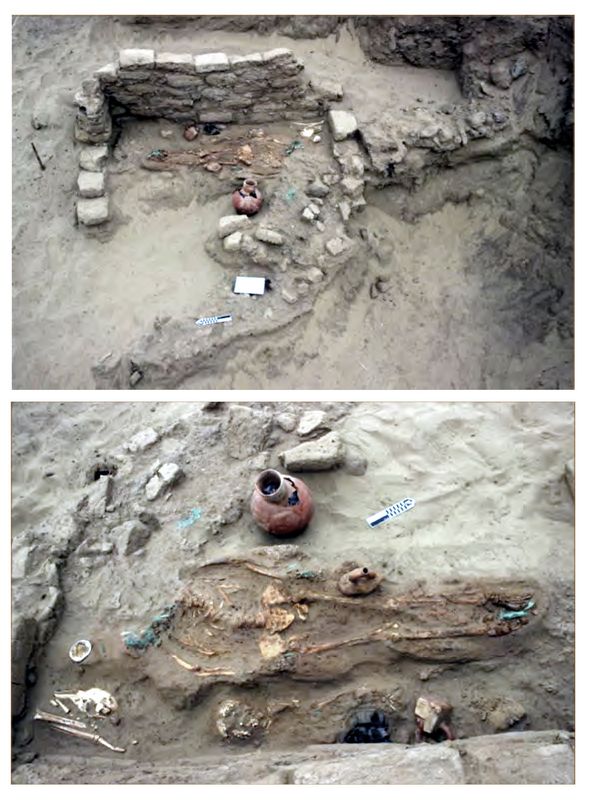 This
funerary context was damaged by an erosional (flooding) event at some
time in antiquity. This context contained two individuals (figs.12-14). A large adobe block appears to have been gently placed atop the
body of the principle personage, who was an adult of indeterminate sex
and who was between the ages of 25-35 at the time of death. Their tomb
contained two ceramic vessels, the remains of a single diadem worn at
the time of death, shell objects, the head and hooves of a butchered
camelid, and the skeletal remains of a 1-2 year-old child placed by the
right side of the personage. A coppersheet object had been placed in
the child’s mouth and hands (a common Moche funerary act). The head of
this person had separated from the body and shifted nearly a meter down
slope and came to rest in a laminated water-born deposit. While poorly
preserved, the crown was fairly complex, and included copper sheet
plates covering both cheeks and decorated with elaborate miniature
bangles.
This
funerary context was damaged by an erosional (flooding) event at some
time in antiquity. This context contained two individuals (figs.12-14). A large adobe block appears to have been gently placed atop the
body of the principle personage, who was an adult of indeterminate sex
and who was between the ages of 25-35 at the time of death. Their tomb
contained two ceramic vessels, the remains of a single diadem worn at
the time of death, shell objects, the head and hooves of a butchered
camelid, and the skeletal remains of a 1-2 year-old child placed by the
right side of the personage. A coppersheet object had been placed in
the child’s mouth and hands (a common Moche funerary act). The head of
this person had separated from the body and shifted nearly a meter down
slope and came to rest in a laminated water-born deposit. While poorly
preserved, the crown was fairly complex, and included copper sheet
plates covering both cheeks and decorated with elaborate miniature
bangles.Figs.12-13: Tomb 4 overall view (top) and detailed view (bottom). The context had been partly damaged by a flooding event in the past. (Photos: Edgar Bracamonte/ Museo Tumbas Reales de Sipán.)
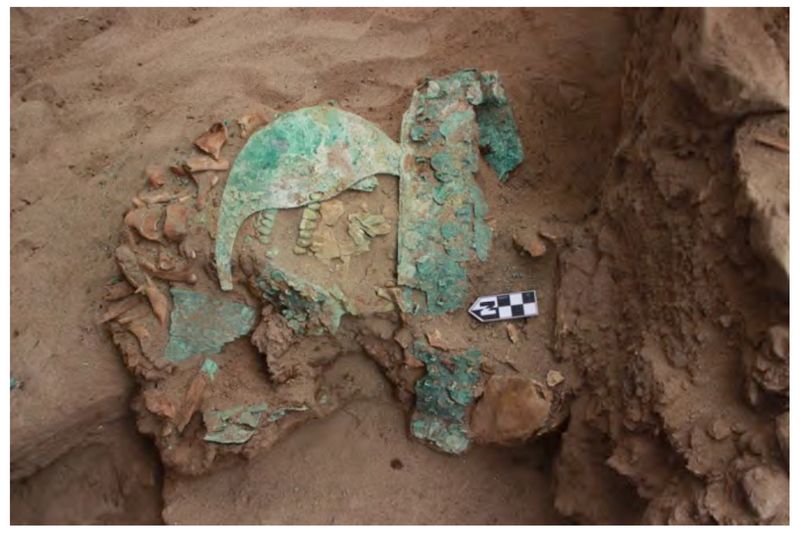 The principal personage of the tomb lacked any signs of
illness or pathology, aside from very minor degenerative changes seen
in the thoracic elements. Three small dental caries were observed in
their posterior teeth, and deposits of dental calculus affected nearly
all of the teeth. No pathological conditions of any kind were observed
in the accompanying child.
The principal personage of the tomb lacked any signs of
illness or pathology, aside from very minor degenerative changes seen
in the thoracic elements. Three small dental caries were observed in
their posterior teeth, and deposits of dental calculus affected nearly
all of the teeth. No pathological conditions of any kind were observed
in the accompanying child.Fig.14: The head of the principal personage had been separated from the body of Tomb 4 and transported by floodwaters down-slope and away of the rest of the body. A copper headband, face bangles, and nose clip still remained mostly attached. (Photo: Edgar Bracamonte/ Museo Tumbas Reales de Sipán)
Hypothesis 1: Moche Royal Kinship and Affiliation
Biodistance analysis was able to incorporate the inherited dental trait data from three individuals in the tombs of Úcupe: (1) Tomb 2 Individual 2 (the adolescent tomb retainer under the subadult principal personage); (2) Tomb 3 Principal Personage, and; (3) Tomb 4 Principal Personage. The remaining skeletal individuals had more than 25% missing data or possessed subadult dentitions that disallowed their study.
Following the standard processes of data winnowing, checks of normalcy, and transformation of the raw data into doubly-normalized C-scores, they first were added to the northern Moche lords biodistance dataset (Klaus et al., 2018) and D2 values were calculated and represented as a hierarchical cluster analysis dendrogram using a standard Between Groups clustering algorithm. The results demonstrate two of these
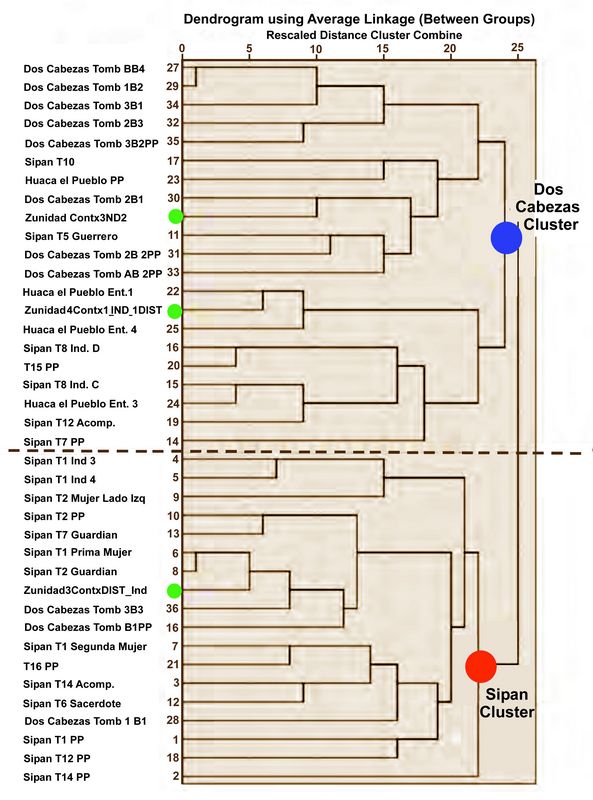 individuals (Tomb 2 Individual 2 and Tomb 4 Principal Personage)
clustered well within the phenetic structures of the so-called “Dos
Cabezas” group (fig.15). The closest relationship the adolescent
retainer had, interestingly, was with the human sacrifice
victim/retainer (female, approximately 15 years old) buried atop the
elite Dos Cabezas Tomb 2 (Donnan, 2007). The principal personage of
Tomb 4 clustered very closely with two of the retainers in the tomb of
the Lord of Úcupe (Bourget, 2014) before joining on as a branch of the
larger Dos Cabezas affiliated cluster. In contrast, the principal personage
of Tomb 3 demonstrated biological affiliation to the “Sipán” cluster.
Their closest inferred generic relationships were shared with the chief
female retainer in the tomb of the iconic Lord of Sipán as well as the
inferred “guardian” of the high status Sipán Tomb 2.
individuals (Tomb 2 Individual 2 and Tomb 4 Principal Personage)
clustered well within the phenetic structures of the so-called “Dos
Cabezas” group (fig.15). The closest relationship the adolescent
retainer had, interestingly, was with the human sacrifice
victim/retainer (female, approximately 15 years old) buried atop the
elite Dos Cabezas Tomb 2 (Donnan, 2007). The principal personage of
Tomb 4 clustered very closely with two of the retainers in the tomb of
the Lord of Úcupe (Bourget, 2014) before joining on as a branch of the
larger Dos Cabezas affiliated cluster. In contrast, the principal personage
of Tomb 3 demonstrated biological affiliation to the “Sipán” cluster.
Their closest inferred generic relationships were shared with the chief
female retainer in the tomb of the iconic Lord of Sipán as well as the
inferred “guardian” of the high status Sipán Tomb 2.Fig.15: Hierarchical cluster dendrogram showing the biological affiliations of the Individuals from Tombs 2, 3, and 4 within the larger “Sipán” and “Dos Cabezas” clusters (image: Haagen Klaus).
R-matrix analysis divided up the biodistance metric dataset into Sipán (High Nobility), Sipán (Lower Nobility), Sipán Tomb Retainers, Dos Cabezas Lords, Dos Cabezas Tomb Retainers, Úcupe Retainers, and the Úcupe 2019 Tombs subsamples. Inclusion of these three new individuals did very little to change past results, generating a bias-corrected
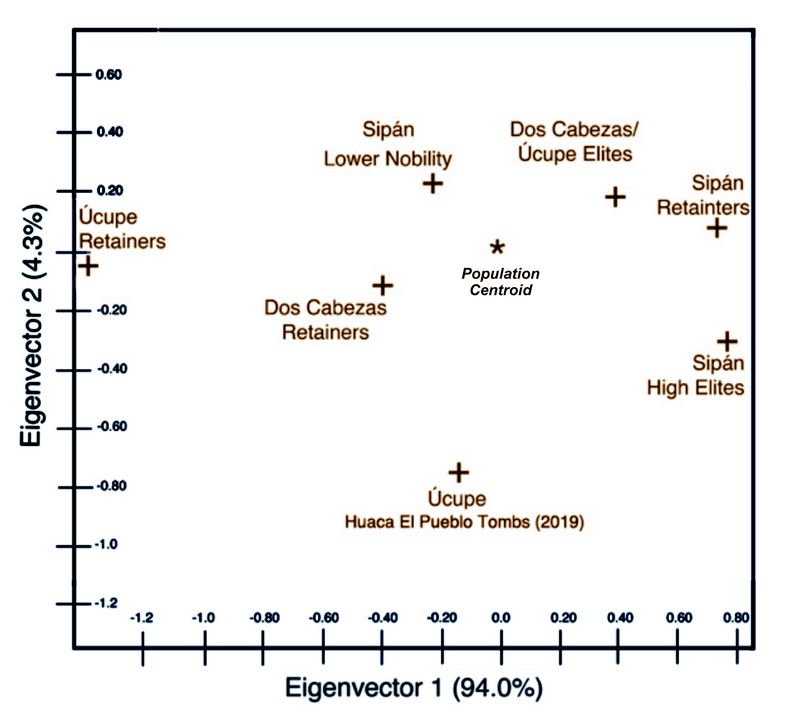 FST of 0.66
indicating an extremely strong degree of heterogeneous structure
(fig.16). Put another way, the subsamples are very different from
one another, and in population genetics, inbreeding is often the cause
of such structure. These groups do not appear to share genes
frequently with one another. This inference is consistent with the
analysis of residual values (expected minus observed genetic variance)
that demonstrates strong negative extralocal gene flow in these groups
and in the 2019 Úcupe tomb occupants especially.
FST of 0.66
indicating an extremely strong degree of heterogeneous structure
(fig.16). Put another way, the subsamples are very different from
one another, and in population genetics, inbreeding is often the cause
of such structure. These groups do not appear to share genes
frequently with one another. This inference is consistent with the
analysis of residual values (expected minus observed genetic variance)
that demonstrates strong negative extralocal gene flow in these groups
and in the 2019 Úcupe tomb occupants especially. Fig.16: Principal components analysis based in R-matrix scores showing the members of the 2019 Úcupe tombs (lower center) as being quite distinct from the Lords of Sipán and Dos Cabezas (image: Haagen Klaus).
Hypothesis 2
Paleopathological observations of ill health or biological stress were few and far between in the people buried in the Úcupe tombs. The osteoarthritis seen in the elite woman of Context 2 Tomb 1 and elite male was neither inconsistent with their ages nor severe in expression. The presence of multiple childhood stress markers (disruption of tooth formation and chronic anemia) was however noted in the remains of the retainer of Tomb 2 and principal personages of Tombs 3 and 4. The oral health of all these individuals was excellent. All other forms of skeletal disease, such as tuberculosis, treponemal disease, scurvy, crypt fenestration enamel defects, pellagra, and mucopolysacchrydosis, and growth defects/anomalies were all absent.
Hypothesis 3
Odds ratio analyses combined the Moche elite from Sipán, Úcupe, and Dos Cabezas (n=38) and compared the proportional prevalence of various disease conditions with Moche commoners from funerary contexts the sites of Huaca Arenal, Huaca Santa Rosa, Inmaculada, El Chorro, Pampa Grande, Huaca Limon, Zarpán, and Huaca El Pueblo (n= 174). The results demonstrate systematically and starkly higher crude prevalence of all skeletal pathological conditions among Moche commoners (fig.17). Odds ratio tests evaluated if these were statistically significant and independent of age-at-death patterns in a skeletal sample that can skew crude prevalence. Statistically
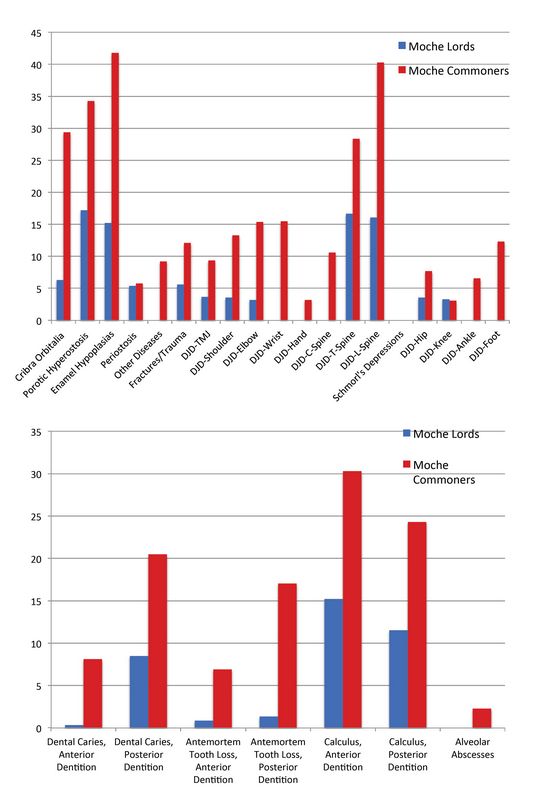 significant higher prevalence of cribra
orbitalia, porotic hyperostosis, and enamel hypoplasias were observed
among the commoner Moche. Prevalence of periostosis, other
skeletal diseases, traumatic injury, and DJD in all the major
loadbearing joint systems, trended strongly towards greater prevalence
among the commoners, though these relationships were not statistically
significant. Crude prevalence of oral pathological conditions (anterior
and posterior dental caries, antemortem tooth loss, calculus, and
alveolar abscesses) again show stark contrasts between the Moche lords
and commoners, with commoners displaying often more than two to five
times the rates of oral diseases. G-test analysis of the prevalence of
oral health conditions demonstrates the same, with systematically and
strongly significantly higher prevalence among the common Moche peoples. This pattern is extremely well defined.
significant higher prevalence of cribra
orbitalia, porotic hyperostosis, and enamel hypoplasias were observed
among the commoner Moche. Prevalence of periostosis, other
skeletal diseases, traumatic injury, and DJD in all the major
loadbearing joint systems, trended strongly towards greater prevalence
among the commoners, though these relationships were not statistically
significant. Crude prevalence of oral pathological conditions (anterior
and posterior dental caries, antemortem tooth loss, calculus, and
alveolar abscesses) again show stark contrasts between the Moche lords
and commoners, with commoners displaying often more than two to five
times the rates of oral diseases. G-test analysis of the prevalence of
oral health conditions demonstrates the same, with systematically and
strongly significantly higher prevalence among the common Moche peoples. This pattern is extremely well defined.Fig.17: Principal components analysis based in R-matrix scores: a (top): post-cranial skeletal traits; b (bottom): dental traits. Both show the members of the 2019 Úcupe tombs (lower center) as being quite distinct from the Lords of Sipán and Dos Cabezas. (images: Haagen Klaus).
Kaplan-Meier survivorship analyses were conducted comparing the effects of enamel defects, cribra orbitalia, porotic hyperostosis, and periostosis on age-at-death between the Moche lords and Moche commoners. The differences between the elite and non-elite Moche survivorship curves for cribra orbitalia was statistically significant in favor of reduced survivorship of commoners affected by this early childhood condition. Survivorship curves for porotic hyperostosis, enamel hypoplasias, and periostosis do not vary significantly between these Moche elites and commoners.
Conclusion:
The above observations allow us to thoroughly test the three research hypotheses. Hypothesis 1 is partially rejected. On one hand, the biological affinity of the previously excavated Lord of Úcupe was not an isolated finding or a fluke. Instead, it appears that more elite individuals at Úcupe were biologically related to the Dos Cabezas elite in the valley to the south. This pattern is now appearing to be increasingly systematic. This finding is not entirely surprising, given that Huaca El Pueblo-Úcupe appears to have been a satellite settlement of Dos Cabezas. The pyramid itself is a smaller-scale architectural copy of the Dos Cabezas complex down to their unique zig-zag walls and X-shaped low relief wall decorations (Bourget, 2014, Klaus et al., 2018). Common makers’ marks on adobe bricks suggest shared administrative activity harnessing the same pools of labor and resources. It would seem Huaca el Pueblo-Úcupe was purposefully built in the Zaña valley, and members of that the extended Dos Cabezas royal lineage were installed there to control the resources in the backyard of Sipán.
Yet, this picture is complicated immensely by the material culture, iconography, and other tangible embodiments of mortuary pattern variation that communicated group identity and affiliation. Just as the aforementioned Lord of Úcupe, the style of masks, V-shaped diadems, face bangles, and other items unambiguously communicate “Sipán” and do not emulate the Dos Cabezas substyle at all. One could even make the argument that some pieces, such as the face mask in Tombs 1 and 2 could have been made by the same artisan(s) that produced the identical masks for Sipán royalty. Likewise, the ceramic vessel offering in Context 2 Tomb 1 were also stylistically analogous to the face-neck jars offering caches in multiple contexts at Sipán. Only a few offering objects in the Úcupe tombs indeed convey what we think is a Dos Cabezas technical or iconographic “signature”, such as a sculptural ceramic bottle of a man with clasped hands and a distinctive “bowl-cut” hairstyle (seen in Dos Cabezas Tomb B and looted assemblages from the site) while nothing comparable exists in Sipán material culture. Further, it should be noted that the quality of the objects, absence of gold or silver items, and degree of tomb complexity seen in these four tombs is each fully consistent with these people as members of the “lower nobility.” They were elite to be sure, but not the highest of Moche status.
These findings speak to a series of larger goals and key questions in the archaeology of
north coast Peru and produce several distinctive contributions to New World archaeology. First, the evidently “hybrid” biocultural identity of Lord of Úcupe discovered in 2008 was part of a larger pattern. This may be a signature of a previously undefined Moche elite lineage in the Zaña valley, Berezkin’s (1978) iconographic analysis and more recent work (Klaus et al. 2018) suggests that differing uses of symbols, motifs, and other forms of elite material culture in the different north coast valleys were representative of five principle elite lineages. This work may point to the lords of Huaca El Pueblo-Úcupe as one such lineage.
One possibility consistent with the evidence points to biological members of the Dos Cabezas lineage were indeed initially transplanted or otherwise established a presence at Úcupe. Then, by the early Middle Moche era and for reasons yet unclear, their political allegiance and social identity may have shifted to embrace the lords of Sipán and produce a new, hybrid biocultural identity and a shift in local geopolitical relationships. At that point, a small-scale event of ethnogenesis would have positioned this group of Moche lords as neither of Sipán or Dos Cabezas, but something new, liminal, and distinct.
These findings also speak to the ways in which Andean archaeologists and those working in the Americas more broadly approach ancient politics. In the past, the Moche elite were seen as a single, centralized, and monolithic entity. Instead, the Moche lords (and the Moche world more broadly) appear to have been composed of a constellation of peoples and identities including at the level of the rulership. This helps challenge long-held simplistic notions of leadership and the static undifferentiated nature of non-Western, non-modern polities. Especially in north coast Peruvian archaeology, these older ways of thinking about rulership and social organization tend to persist. Also, this research illustrates that relative ideological and cultural unity among these ancient Moche groups does not necessarily imply biological unity.
It seems increasingly plausible that each northern valley likely possessed at least one or more elite administrative entities and they practiced, embodied, and reproduced “Moche” in their own distinctive ways. Further, we may wish to consider how suzerainty (where a dominant polity permits their subordinates extensive autonomy and sovereignty) and reciprocity-driven cooperation applied to Moche interactions. Also, the presence of what at least started out as a satellite center of the Dos Cabezas Moche brings up the opportunity to evaluate Andean concepts of “territory.” Ethnohistoric analysis by Rostworowski (1985) identified cases involving communities of one lord located deep inside the borders of another ruler’s polity. This suggests approaches to territory that were decidedly non-linear, more fluid, and not predatory/conquest based. Again, such a possibility points to the negotiated nature of royal identity and the dialectics of power dynamics between different Moche royal lineages.
Hypothesis 2 is accepted. The high-status of these Moche lords from Úcupe is correlated to a low prevalence of pathological conditions in the skeleton. While the sample is small, the general lack of stress markers made this group of people paleopathologically “unremarkable.” They do appear significantly buffered from stress or exposure to disease. The excellent oral health of these people is perhaps some of the best evidence of this fact. High-status individuals, both in Peru and cross-culturally, tend to consume consistently high-quality diets that contain lower propositions of starchy carbohydrates as a function of social privilege and power (Larsen, 2015; Klaus et al., 2017d). In the case of the Moche, the lords portrayed themselves as having ultimate power over life, death, the natural world, and the cosmos (Bourget, 2016). They gave themselves rights and access to all forms of social and economic capital. In this case, preferential dietary quality is clear. A fairly linear relationship exists between oral diseases and the sugar/carbohydrate proportional contribution to a diet over time. The lack of oral pathological conditions are very evident here, and can be contrasted with that of lower status commoner Moche (including those studied previously at Huaca El Pueblo) among whom oral health is extremely poor.
Hypothesis 3 is partially accepted. It builds on Hypothesis 2 and takes a comparative epidemiological perspective on high-status Moche health. Cribra orbitalia, porotic hyperostosis (chronic childhood anemia) and enamel hypoplasias (acute childhood stress), which rank as the most significant stress markers that can be observed in the human skeleton, are all systematically higher among the Moche commoners. Periostosis was rare in both groups and is in general a very rare disease condition on the pre-Hispanic north coast (Klaus and Tam, 2009). The lack of significant differences in prevalence patterns of DJD and other arthritic changes indicates that while the non-elite people represented the economically productive engine of the Moche political economy, their systems of labor were neither excessive or particularly exploitative (and see Klaus et al. [2010, 2017d] for further perspectives on the relationships between north coast economic organization and the epidemiology of DJD).
The most jarring paleopathological differences were seen in the patterns of diet-mediated oral disease. Individual G-values and summary G-statistics expressing overall differences were consistent and exceedingly strong. The non-elite Moche collectively endured far worse oral health than their leaders. This was likely the single greatest source of physical suffering for these peoples. Their diets, while generally diverse, featured far greater proportions of starchy sugars (e.g., maize, beans) (Turner and Klaus, 2020). Overall, these data indicate an epidemiological bi-partition existed in the Moche world between the lived or embodied experiences of elites and non-elites. All of the negative biocultural health outcomes were concentrated among the nonelite or low-status peoples. This structure of socioeconomic and biological inequality continues on into the late pre-Hispanic era (Klaus et al., 2017d) and into the Colonial period (Klaus and Tam, 2009, 2010).
The relationship between early life stress and survivorship is less clear. A younger-age at death was found to be associated with early life chronic anemia among the lower-status commoner Moche. This is expected in terms of the DOHaD, life history frameworks, and paleopathological/archaeological contexts. Yet, none of the other key indicators demonstrated this relationship, despite clear graphical separation of mortality curves. Lack of statistical significance here is almost certainly a direct function of the small Moche elite sample size. Clearly, this approach is vital to further explore in future research as new samples and tombs are excavated.
References:
Alva, Walter 1994. Sipán. Colección Cultura y Artes del Perú. Cerveceria Backus and Johnston SA, Lima.
__________ 2001, The Royal Tombs of Sipán: Art and Power in Moche Society. In Moche Art and Archaeology in Ancient Peru, edited by Joanne Pillsbury, pp. 223-245: National Gallery of Art, Washington, DC.
Bawden, Garth 1996. The Moche. Blackwell, Cambridge, MA.
Bentley, Sylvia A., and Haagen D. Klaus 2016. Reconsidering Retainers: Offerings, Sacrifice, and Burial in Ancient Peru. In Ritual Violence in the Ancient Andes: Reconstructing Sacrifice on the North Coast of Peru, edited by Haagen D. Klaus and J. Marla Toyne, pp. 266-290. University of Texas Press: Austin.
Benson, Elizabeth P. 2012. The Worlds of the Moche on the North Coast of Peru. University of Texas Press, Austin.
Berezkin, Yuri 1978. The Social Structure of the Mochica Through the Prism of Mythology (ancient Peru). In Russian with English summary. Vestnik drevnie istorii 3: 38-59.
Boldsen, Jesper, George R. Milner, Lyle W. Konigsberg, and James W. Wood 2002. Transition Analysis: A New Method for Estimating Age from Skeletons. In
Paleodemography: Age Distributions from Skeletal Samples edited by Robert D. Hoppa and James W. Vaupel, pp. 73-106. Cambridge University Press, Cambridge U.K.
Bourget, Steve 2014. Les rois mochica: Divinité et pouvoir dans le Pérou ancien. Somogy, éditions d’art et MEG, musée d’ethnographie de Genève, Paris.
____________ 2016. Sacrifice, Violence, and Ideology Among the Moche: The Rise of Social Complexity in Ancient Peru. University of Texas Press, Austin.
Bourget, Steve, and Kimberly L. Jones (editors) 2008. The Art and Archaeology of the Moche: An Ancient Andean Society of the Peruvian North Coast. University of Texas Press, Austin
Bracamonte, Edgar 2015. Huaca Santa Rosa de Pucalá y la organizacion territorial de valle de Lambayeque. Ministerio de Cultura/Unidad Ejecutora 005, Lima/Chicalyo.
Buikstra, Jane E. (editor). 2019. Ortner’s Identification of Pathological Conditions in Human Skeletal Remains. 3rd ed. Academic Press, Amsterdam.
Buikstra, Jane E., and Douglas H. Ubelaker 1994. Standards for Data Collection from Human Skeletal Remains. Fayetteville: Arkansas Archaeological Survey Research Series No. 44.
Castillo, Luis Jaime 2000. La presencia wari en San José de Moro. Boletin de Arqueologia PUCP No. 4: 143-179.
Castillo, Luis Jaime, and Christopher B. Donnan 1994. Los Mochicas del norte y los Mochicas del sur: una perspectiva desde el valle de Jequetepeque. In Vicús, edited by Krzysztof Makowski, pp. 143–181. Colección Arte y Tesoros del Perú. Banco de Crédito del Perú, Lima.
Donnan, Christopher B. 1995. Moche Funerary Practice. In Tombs for the Living: Andean Mortuary Practices, edited by Tom D. Dillehay, pp. 111–160. Dumbarton Oaks, Washington, DC.
______________ 2007 Moche Tombs at Dos Cabezas. Cotsen Institute of Archaeology Press, Los Angeles.
______________ 2011 Moche Substyles: Keys to Understanding Moche Political Organization. Boletín del Museo Chileno de Arte Precolombino 16: 105-118.
Eeckhout, Peter, and Lawrence S. Owens 2008. Human Sacrifice at Pachacamac. Latin American Antiquity 19:375–398.
Hamilton, Laurel S. 2016. Ritual Killing, Mutilation, and Dismemberment at Huaca de la Luna: Sharp Force Trauma Among Moche Sacrifice Victims in Plazas 3A and 3C. In Ritual Violence in the Ancient Andes: Reconstructing Sacrifice on the North Coast of Peru, edited by Haagen D. Klaus and J. Marla Toyne, pp. 29-63. University of Texas Press: Austin.
Jacobi, Keith P. 2000. Last Rights for the Tipu Maya: Genetic Structuring in Colonial Cemetery. University of Alabama Press, Tuscaloosa.
Kaplan, Edward L., and Paul Meir 1958. Nonparametric Estimation from Incomplete Observations. Journal of the American Statistical Association 53: 457–481.
Klaus, Haagen D. 2008. Out of Light Came Darkness: The Bioarchaeology of Mortuary Ritual, Health, and Ethnogenesis in the Lambayeque Valley Complex, North Coast of Peru (A.D. 900-1750). PhD dissertation, Department of Anthropology, The Ohio State University: Columbus.
__________ 2014. Frontiers in the Bioarchaeology of Stress and Disease: Cross- Disciplinary Perspectives from Pathophysiology, Human Biology, and Epidemiology. American Journal of Physical Anthropology 155: 294-308.
Klaus, Haagen D. and Izumi Shimada 2016. Bodies and Blood: Middle Sicán Human Sacrifice in the Lambayque Valley Complex (AD 900-1100). In Ritual Violence in the Ancient Andes: Reconstructing Sacrifice on the North Coast of Peru, edited by Haagen D. Klaus and J. Marla Toyne, pp. 120-149. University of Texas Press: Austin.
Klaus, Haagen D and Manuel E. Tam 2009. Contact in the Andes: Bioarchaeology of Systemic Stress in Postcontact Mórrope, Peru. American Journal of Physical Anthropology 138: 356-368
___________ 2010. Oral Health and the Postcontact Adaptive Transition: A Contextual
Reconstruction of Diet in the Colonial Lambayeque Valley Complex, Peru. American Journal of Physical Anthropology 141: 594-609
Klaus, Haagen D., and J. Marla Toyne (editors) 2016. Ritual Violence in the Ancient Andes: Reconstructing Sacrifice on the North Coast of Peru. University of Texas Press: Austin.
Klaus, Haagen D., Clark Spencer Larsen, and Manuel E. Tam 2009. Economic Intensification and Degenerative Joint Disease: Life and Labor in Postcontact
Peru. American Journal of Physical Anthropology 139: 204-221.
Klaus, Haagen D., Jorge Centurión, and Manuel Curo. 2010. Bioarchaeology of Human Sacrifice: Violence, Identity, and Ritual Killing at Cerro Cerrillos, Peru. Antiquity 84: 1102-1122.
Klaus, Haagen D., Bethany L. Turner, Fausto Saldaña, Samuel Castillo, and Carlos Wester 2016. Human Sacrifice at the Chotuna-Chornancap Archaeological Complex:
Characteristics and Variations of Generative Ritual Violence from the Chimú to
Inka Occupations. In Ritual Violence in the Ancient Andes: Reconstructing
Sacrifice on the North Coast of Peru, edited by Haagen D. Klaus and J. Marla
Toyne, pp. 178-210. Austin: University of Texas Press.
Klaus, Haagen D., Amanda Harvey, and Mark N. Cohen 2017 (editors). Bones of Complexity: Bioarchaeological Case Studies of Social Organization and
Skeletal Biology. University of Florida Press, Gainesville.
Klaus, Haagen D., Amanda Harvey, and Mark N. Cohen 2017b. Human Biology in Ancient Complex Societies: Some Concepts of Bioarchaeology. In: Bones of Complexity: Bioarchaeological Case Studies of Social Organization and
Skeletal Biology, edited by Haagen D. Klaus, Amanda Harvey, and Mark N. Cohen, pp.
1-29. University of Florida Press, Gainesville.
Klaus, Haagen D., Mark Nathan Cohen, Marie Elaine Danforth, and Amanda R. Harvey. 2017c. Bioarchaeology and Social Complexity: Departing Reflections and Future Directions. In: Bones of Complexity: Bioarchaeological Case Studies of Social Organization and Skeletal Biology, edited by Haagen D. Klaus, Amanda Harvey, and Mark N. Cohen, pp. 450-468. Gainesville: University Press of Florida.
Klaus, Haagen D., Izumi Shimada, Ken-ichi Shinoda, and Sara Muno
2017d. Middle Sicán Mortuary Archaeology, Skeletal Biology, and Genetic Structure in Ancient South America. In Bones of Complexity: Bioarchaeological Case Studies in Social Organization and Skeletal Biology, edited by Haagen D. Klaus, Amanda Harvey, and Mark N. Cohen, pp. 408-449. University Press of Florida, Gainesville.
Larco Hoyle, Rafael 1938. Los Mochicas, Vol. 1. Casa Editorial La Cronica y Variedades, Lima.
____________ 1939. Los Mochicas, Vol. 2. Empresa Editoral Rimac, Lima.
Larsen, Clark Spencer 2015. Bioarchaeology: Interpreting Behavior from the Human Skeleton. 2nd edition. Cambridge University Press, Cambridge, U.K.
Millaire, Jean-François 2002. Moche Burial Patterns: An Investigation into Prehispanic Social Structure. British Archaeological Report International Series 1066, Oxford, U.K.
Proulx, Donald A. 2001. Ritual Uses of Trophy Heads in Ancient Nasca Pottery. In Ritual Sacrifice in Ancient Peru, edited by Elizabeth P. Benson and Anita G. Cook, pp. 119–136. University of Texas Press, Austin.
Quilter, Jeffery, and Luis Jaime Castillo (editors) 2010. New Perspectives on Moche Political Organization. Dumbarton Oaks, Washington, D.
Quilter, Jeffery, and Michelle L. Koons. 2012. The Fall of the Moche: A Critique of Claims for South America’s First State. Latin American Antiquity 23: 127-143.
Relethford, John H. 2016. Biological Distance and Population Genetics in Bioarchaeology. In Biological Distance Analysis: Forensic and Bioarchaeological Perspectives, edited by Marin A. Pilloud and Joseph T. Hefner, pp. 23-33. Academic Press, Amsterdam.
Rostworowski, María 1985. Patronyms with the Consonant F in the Guarangas of Cajamarca. In Andean Ecology and Civilization, edited by Shozo Masuda, Izumi Shimada, and Craig Morris, pp. 401-421. University of Tokyo Press, Tokyo.
Shimada, Izumi 1994a. Pampa Grande and Mochica Culture. University of Texas Press, Austin.
__________1994b. Los modelos de la organizacion sociopolitical de la cultura Moche. In Moche: propuestas y perspectivas, edited by Santiago Uceda and Elías Mujica, pp. 359-387. Travaux de l’Institut Français d’ Etudes Andines, Lima.
Sokal, Robert R., and F. James Rohlf 1995. Biometry: The Principles And Practice Of Statistics In Biological Research. W.H. Freeman, NewYork.
Stojanowski, Christoper M. 2005. The Bioarchaeology of Identity in Spanish Florida: Social and Evolutionary Transformation Before, During, and After Demographic Collapse. American Anthropologist 107: 417-431.
___________2013. Ethnogenetic Theory and New Directions in Biodistance Research. The Dead Tell Tales: Essays In Honor Of Jane E. Buikstra edtited by Maria Ceclia Lozada and Barra O’Donnabhain, pp. 71-82. Cotsen Institute of Archaeology Press, Los Angeles.
Stojanowski, Christopher M., and Michael A. Schillaci 2006. Phenotypic Approaches for Understanding Patterns of Intracemetery Biological Variation. Yearbook of Physical Anthropology 49: 49-88.
Strong, William D., and Clifford Evans 1952. Cultural Stratigraphy in the Virú Valley Northern Peru: The Formative and Florescent Epochs. Columbia University Press, New York.
Tung, Tiffiny A. 2012. Violence, Ritual, and the Wari Empire: A Social Bioarchaeology of Imperialism in the Ancient Andes. University Press of Florida, Gainesville.
Turner, Bethany L., and Haagen D. Klaus. 2020 Diet, Nutrition, and Foodways on the North Coast of Peru: Bioarchaeological Perspectives on Adaptive Transitions. Springer, Cham.
Turner, Christy G. II, Christian R. Nichol, and G. Richard Scott 1991. Scoring Procedures for Key Morphological Traits of the Permanent Dentition: The
Arizona State University Dental Anthropology System. In Advances in Dental
Anthropology, edited by Marc A. Kelley and Clark Spencer Larsen, pp. 13–31. Wiley-
Liss, New York.
Verano, John W. 1997. Human Skeletal Remains from Tomb 1, Sipán (Lambayeque River Valley, Peru); and their Social Implications. Antiquity 71: 670-82.
Waldron, Tony 2007. Paleoepidemiology: The Epidemiology of Human Remains. Routledge, London.
Willey, Gordon R. 1953. Prehistoric Settlement Patterns in the Virú Valley Peru. U.S. Government Printing Office, Washington, D.C.
.
.
.
Fig.2: M.
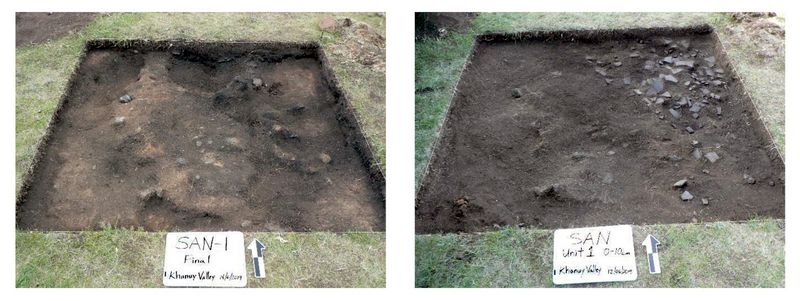
Fig.12 M

Recent Foundation grants: general Archaeology Grants Program w/map
Copyright © 2022 Rust Family Foundation